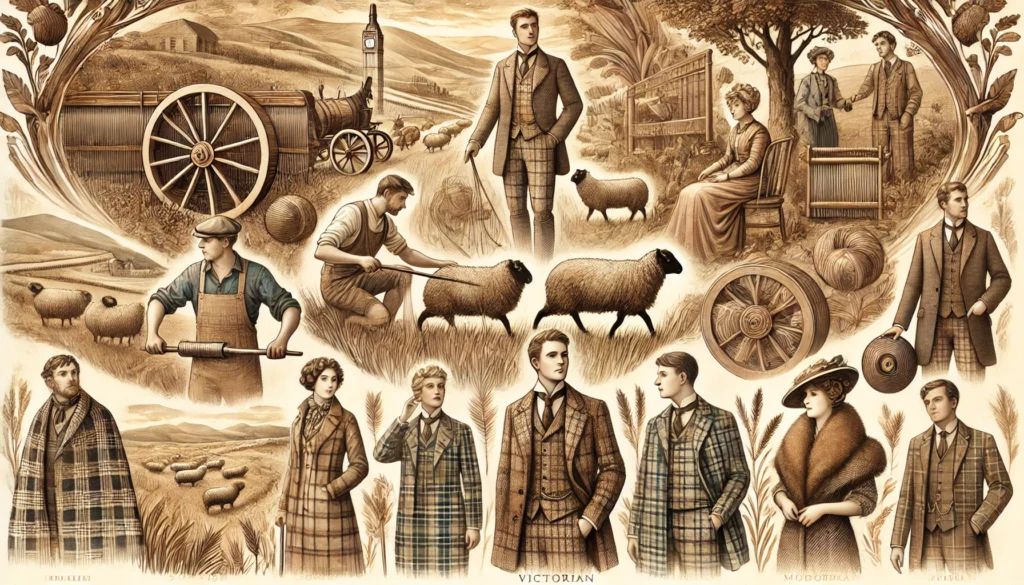Tweed fabric occupies an esteemed place among textiles. Famed for its rich texture, warmth and timeless charm, tweed is a durable woolen weave fabric with roots dating back to Scotland and Ireland’s rugged terrain – originally intended to keep outdoor wear dry on wet terrain – now found as a fashion staple with endless versatility spanning fashion shows to outdoors activities & more!
For fabric enthusiasts or curious folk interested in learning more about Tweed this guide is your one stop solution containing its history, types, uses & more.
History and Origins of Tweed Fabric

Tweed Fabric’s History Tweed originated in Scotland and Ireland where local artisans created it by weaving. Tweed’s initial popularity emerged during the 18th and 19th century with Scottish landowners wearing it as hunting attire; later becoming popular as outerwear or accessories fabrics as time went on.
Characteristics of Tweed Fabric
Tweed is well known for its durability and insulation properties.
- Durable: Built to withstand wear and tear from outdoor conditions, tweed stands up well under pressure from wear.
- Insulation: its dense weave holds in heat naturally providing natural warmth.
- Texture and Pattern: Tweed yarn is often dyed before weaving to produce its iconic herringbone, houndstooth, and check patterns.
- Water Resistance: Due to natural oils present in wool fibres, tweed provides some water resistance that makes it suitable for humid climates.
- Tweed stands out among its counterparts by using innovative weaving techniques and wool, giving it its signature rough surface texture, making it not only functional but also fashionable.
Types of Tweed Fabric
Tweed Fabric Types One of the hallmarks of its versatility lies in its wide array of different tweed types; each with their own individual traits.
- Harris Tweed: It is world renowned for its authenticity. Woven on the Isle of Harris by local islanders using traditional techniques, Harris Tweed meets stringent quality requirements before receiving its official label as authentic Harris Tweed.
- Donegal Tweed Fabric: from County Donegal in Ireland is widely recognized for its vibrant flecks woven into its fabric, lending rustic charm and vibrant patterns that stand out.
- Diamond Tweed: Features an elegant, interlocking diamond pattern, adding depth and sophistication to outerwear.
- Shetland Tweed: Made from Shetland sheep wool, is lighter and softer than traditional varieties and often featured on lighter garments such as suits or jackets.
- Houndstooth Tweed: With its signature broken check pattern and classic style, Houndstooth tweed remains popular with fashion-minded individuals.
- Chevron Tweed: Known for its bold, zigzag “V” pattern, chevron tweed brings a striking, modern edge to classic tweed.
Uses of Tweed Fabric in Fashion and Beyond
Tweed fabric is widely recognized for its adaptable nature and can be found across industries; common applications of Tweed include:
- Clothing and Fashion: Classic Tweed jackets, blazers, skirts and trousers have always been part of fashion collections due to its distinctive texture and warmth – an increasingly sought after option during colder climates.
- Outerwear: Tweed’s rugged durability and insulation properties make it perfect for coats, capes and hats, adding both style and functionality to outerwear.
- Accessories: Thanks to its robust nature, Tweed can also make stylish yet practical accessories like bags, wallets and shoes that boast luxury with texture for stylish outerwear fashionistas.
- Home Decor: Tweed adds warmth and character to home decor from upholstery to throw pillows, thanks to its robust quality that makes it suitable for heavy duty items like sofas and chairs.
The Sustainable Appeal of Tweed
With increasing awareness of sustainable eco-friendly fashion, tweed fabric has gained renewed appreciation. Wool, the primary material used in tweed, is a natural and biodegradable fiber. Additionally, the production of traditional tweed fabrics, like Harris Tweed, adheres to slow fashion principles. Tweed’s durability and timeless appeal mean garments made from this fabric are long-lasting, making it a conscious choice for eco-friendly fashion.
Tips for Caring for Tweed Fabric
Proper care of tweed garments and accessories will extend their longevity while keeping them looking their best. Here are a few tips for maintaining this fabric:
- Spot Cleaning: Tweed fabric resists dirt accumulation but spot cleaning using damp cloth may help eliminate minor stains on its surface.
- Dry Cleaning: Wool can stretch in water, which makes dry-cleaning garments the optimal method.
- Brushing: Gently brushing fabric keeps it neat-looking while eliminating dust lint build-up on its fibers.
- Storage: To prevent moth damage to tweed items, store them in a cool and dry location with cedar balls or moth repellent sachets nearby.
Why Choose Tweed Fabric?
Tweed fabric offers the ideal combination of practicality and elegance, making it suitable for various uses. Tweed continues to captivate fashion designers and consumers for various reasons:
- Aesthetic Appeal: With its rich colors and distinctive patterns, tweed adds rustic charm to any ensemble or decor piece.
- Versatility: Tweed fabric offers endless versatility when worn casually or semi-formal; suitable for casual, semiformal and formal settings alike and perfect in colder climates year-round.
- Longevity: Withstanding wear without loss in quality makes tweed an investment worthy of consideration as part of your wardrobe for years.
Tweed as Timeless Charm
From Scotland’s highlands to global runways, tweed fabric has come a long way since it first emerged centuries ago, offering both rugged resilience and refined elegance in equal measures. No matter if it be for its historical allure or sustainable qualities; or simply for its distinct look and feel.
Tweed remains one of the go-to fabrics when it comes to both fashion and interior design projects alike. When shopping or designing next time around consider its timeless charm- it could just make the perfect addition to any collection.